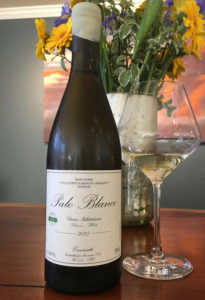
2017 Envinate, Palo Blanco, Listan Blanco/Palomino, Tenerife, Canary Islands, Spain.
This energy driven white, by Envinate, is sourced from a tiny 1.5ha vineyard of centenarian (hundred year old) cordon trenzado, which is the named for the braided vine system used on the windswept volcanic hillside, Listan Blanco, also known as Palomino (the Sherry grape) at 600m elevation, and is named for the area where it’s planted on the Island of Tenerife. This Canary Islands white shows the terroir intensity and is an earthy spice, bone dry wine with a crisp saltiness and electric form, it was fermented naturally, whole cluster pressed before racking off the skins into cement vat where it is done without malo-latic fermentation and raised in old large Friulian oval foudres for 10 months. While known in the natural wine world for their exciting Listan Nergo red wines, Envinate is gaining a reputation for their whites, especially their Taganan Blanco, which is made from a field blend mix of mostly Listan Blanco, Albillo Criollo, Marmajuelo, Gual, and Malvasia, but includes a few grapes no one can seem to identify, as well as this 100% Listan Blanco. As noted by me and other top critics, Envinate is a talented group of 4 friends, consisting of winemakers Roberto Santana, Alfonso Torrente, Laura Ramos, and José Martínez. This gang of 4, as they have become known, formed back in 2005 while studying enology at the University of Miguel Hernandez in Alicante and decided that they all would make wine together, regardless of where they ended up. Then after their graduation, they formed a winemaking consultancy, which evolved into Envínate, a project, now based on Tenerife, that focuses on exploring distinctive parcels mainly in the Atlantic regions of Spain, including most famously the Ribeira Sacra in Galicia and the Canary Islands, as well as one site influenced by the Mediterranean sea in the Alicante region along with a plot in Extremadura. I’ve been following Envínate for many vintages now and every time I try their wines I find something new and exciting in them, and the current releases are thrilling, quite honestly there is nothing quite like them!
The 2017 Palo Blanco is slightly funky on the nose at first, but that blows off quickly to reveal a vibrant and spicy dry white wine that gains class and stylistic charm in the glass with a glistening pale golden hue, it is a nervy and exciting wine that expresses its terroir and especially performs well with sea food and or soft cheeses. Brisk acidity and restrained fruits hides the depth at first, but as the Palo Blanco opens it fills out and adds a graceful texture with a core of citrus fruit and wet rock along with dried pineapple, ginger, pepper/flint, mouth watering saline as well as white peach, quince and a touch of waxy verbena. Palomino, rarely achieves what you find here, and this is incredibly unique, I can only think of examples like those of Sadie Family in South Africa and Laura Lorenzo in Galicia that make wines from this grape that is on this level. The collective aim, as they put at Envinate, is to make profoundly pure and authentic wines that express the terruño of each parcel in a clear and raw/authentic way, as this 2017 Palo Blanco transparently shows in every detail. To make this happen to their satisfaction, there are no chemicals used in any of the Envínate farmed or used vineyards, with every parcel picked by hand, all the grapes are foot-trodden old school style, and the wines are fermented exclusively with wild yeasts, with a varying proportion of whole grape clusters (for the reds) included. As for aging, as mentioned above, the wines are raised in old barrels and the absolute minimum amount of sulfur is used and only added at bottling, if needed. The results in the bottle are thrilling, there are some of the most exciting, slightly funky and honest wines being produced in Spain today. I tend to describe them as wild and remote as the regions from which they come, in particular these from the Canary Islands, which if you hadn’t noticed is an island chain off the coast of north Africa that were planted to vines during the Spanish colonial era in the new world with the Missionaries taking the same selection of vines to the western coast of the Americas from Chile all the way up to present day Sonoma in California starting in the 1500s. If you want to discover these wines, especially this rare white, you’ll have to work a bit, but it is worth it!
($45 Est.) 93 Points, grapelive